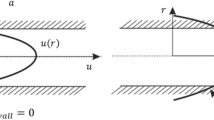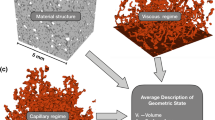Abstract
The highly compressible fluid flow through a three-scales rigid porous medium (pore, fracture, macroscopic sample) is investigated using a homogenization method. The macroscopic description is strongly dependent on the separation of the different scales, and three cases are considered. The pores either play the role of a compressible fluid reservoir, introduce a memory effect, or are ignored, respectively. The homogenization result is compared to classical phenomenological models that are available in the case of slightly compressible fluids. Pseudo-steady state models are shown to give a rough description of the phenomenon.
Similar content being viewed by others
Abbreviations
- C*:
-
gas compressibility coefficient
- f:
-
subscript for the fractures
- F :
-
nonlinear function
- h :
-
positive integer
- ĩ :
-
identity tensor
- k :
-
subscript taking on the values p for the pores and f for the fractures
- \(\tilde k_{{\text{p,}}} \tilde k_{\text{f}} \) :
-
particular solutions for the velocity fields in the pores and the fractures, respectively
- \(\tilde K_{{\text{p,}}} \tilde K_{\text{f}} \) :
-
pore and fracture permeability tensors, respectively
- l,l′,l″ :
-
characteristic lengths for the pore scale, the fracture scale and the macroscopic medium, respectively
- m :
-
positive integer
- n,n′ :
-
pore porosity and fracture porosity, respectively
- n′ :
-
normal unit vector
- p:
-
subscript for the pores
- P 0 :
-
initial pressure
- P p,P f :
-
pore and fracture pressures, respectively
- q :
-
interporosity flow
- Q :
-
dimensionless number
- r :
-
positive integer
- s :
-
characteristic coefficient of a fractured rock
- S :
-
Strouhal number
- t,T :
-
time variables for the pores and the fractures, respectively
- T p,T f :
-
characteristic times for the pores and the fractures, respectively
- u p,u f :
-
pore and fracture fluid displacements, respectively
- v p,v f :
-
pore and fracture fluid velocities, respectively
- v p k :
-
order of magnitude ofV k , due to the macroscopic pressure gradient
- v t k :
-
order of magnitude ofv k , due to the temporal change of pressure
- x, x′, x″ :
-
space variables for the pore, fracture and macroscopic scales, respectively
- α,Β,γ :
-
ratios between the different characteristic lengths
- γ, γ′ :
-
boundaries of the pores and the fractures, respectively
- δ:
-
Laplace operator
- ∇:
-
gradient operator
- ε :
-
small parameter
- λ,Μ :
-
fluid viscosities
- ρ0:
-
initial density
- ρ p,ρf:
-
pore and fracture densities, respectively
- Τ :
-
particular solution for the pressure
- Τ p,Τf:
-
characteristic times for the pores and the fractures, respectively
- Ω :
-
pulsation
- Ω, Ω′:
-
periods at the pore and fracture scales, respectively
- Ωp, Ω′sp, Ω′f :
-
parts of the period occupied by the pores, the solid plus the pores and the fractures
- 〈Φ〉Ω, 〈Φ〉Ω′ :
-
volume averages of the quantityΦ on Ω, Ω′, respectively
- 〈Φ〉eff :
-
particular volume average on Ω′
References
Arbogast, T., Douglas, J., and Hornung, U.: 1990, Derivation of the double porosity of single-phase flow via homogenization theory,SIAM J. Math. Anal. 21(4), 823–836.
Auriault, J. L.: 1983, Effective macroscopic description for heat conduction in periodic composites,J. Heat Mass Transfer,26(6), 861–869.
Auriault, J. L.: 1991, Heterogeneous medium. Is an Equivalent macroscopic description possible?Int. J. Eng. Sci 29(7), 785–795.
Auriault, J. L. and Boutin, C.: 1992, Deformable porous Media with double porosity. Quasi-statics I: coupling effects,Transport in Porous Media 7, 63–82.
Auriault, J. L. and Boutin, C.: 1993, Deformable porous media with double porosity. Quasi-statics II: memory effects,Transportin Porous Media 10, 153–169.
Auriault, J. L. and Boutin, C.: 1994, Deformable porous media with double porosity. III: Acoustics,Transportin Porous Media 14, 143–162.
Auriault, J. L. and Royer, P.: 1993a, Double conductivity media: a comparison between phenomenological and homogenization approaches,Int. J. Heat Mass Transfer 36(10), 2613–2621.
Auriault, J. L. and Royer, P.: 1993b, Ecoulement d'un gaz dans un milieu poreux à double porosité,C. R. Acad. Sci. Paris ser 2 (II) 431–436.
Auriault, J. L., Strzelecki, T., Bauer, J., and He, S.: 1990, Porous deformable media saturated by a very compressible fluids: Quasi-staticsEur. J. Mech. A/Solids 9(4), 373–392.
Barenblatt, G. I.: 1963, On certain boundary value problems for the equations of seepage of liquid in fissured rocks,PMM,27(2), 348–350.
Barenblatt, G. I., Zheltov, Iu., and Kochina, I. N.: 1960, Basic concept in the theory of seepage of homogeneous liquids in fissured rocks,PMM,24(5), 852–864.
Barenblatt, G. I., Entov, V. M., and Ryzhik, V. M.: 1990,Theory of Fluid Flows through Natural Rocks, Kluwer Academic Publishers, Dordrecht.
Bensoussan, A., Lions J. L., and Papanicolaou G. C.: 1978,Asymptotic Analysis for Periodic Structures, North-Holland Publishing Co., Amsterdam.
Bibby, R.: 1981, Mass transport of solutes in dual-porosity media,Water Resour. Res. 1075–1081.
Chen, Z. X.: 1989, Transient flow of slightly compressible fluids through double-porosity, double-permeability systems — A state of the art review,Transport in Porous Media 4, 147–184.
Chen, Z. X.: 1990, Analytical solutions for the double-porosity, double-permeability and layered systems,J. Petrol. Sci. Eng. 5, 1–24.
Gringarten, A. C.: 1984, Interpretation of tests in fissured and multilayered reservoirs with double porosity behavior: theory and practice,J. Petrol. Technol. Distinguished Authors Series 4, 549–464.
Hornung, U. and Showalter, R. E.: 1990, Diffusion models for fractured media,J. Math. Anal. Appl. 147, 69–80.
Levy, T.: 1990, Filtration in a porous fissured rock. Influence of the fissure connexity,Eur. J. Mech. B/Fluids 9(4), 309–327.
Levy T. and Sanchez-Palencia, E.: 1975, On boundary conditions for fluid flow in porous media,Int. J. Engng. Sci. 13, 923–940.
Royer, P. and Auriault, J. L.: 1992, Very compressible fluid flow through a porous rigid medium with double porosity,Studia Geot. Mech. 13(1–2), 65–77.
Strzelecki, T., Bauer, J., and Auriault, J. L.: 1993, Constitutive equations of a gas-filled two phase medium,Transport in Porous Media 10, 197–202.
Sanchez-Palencia, E.: 1990, Non homogeneous media and vibration theory,Lecture Notes in Physics 127, Springer, Berlin.
Van Golf-Racht, T. D.: 1982,Fundamentals of Fractured Reservoir Engineering, Elsevier, New York.
Warren, J. O. and Root, P. J.: 1963, The behaviour of naturally fractured reservoirs,Soc. Petrol. Eng. J., 254–255.
Zimmerman, R. W., Chen, G., Hadgu, T., and Bodvarsson, G. S.: 1993, A numerical dual-porosity model with semianalytical treatment of fracture/matrix flow,Water Resour. Res. 29(7), 2127–2137.
Author information
Authors and Affiliations
Rights and permissions
About this article
Cite this article
Royer, P., Auriault, JL. Transient quasi-static gas flow through a rigid porous medium with double porosity. Transp Porous Med 17, 33–57 (1994). https://doi.org/10.1007/BF00624049
Received:
Revised:
Issue Date:
DOI: https://doi.org/10.1007/BF00624049




